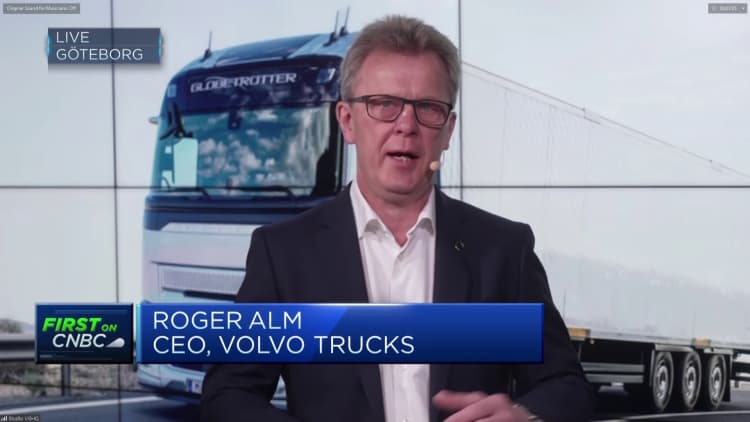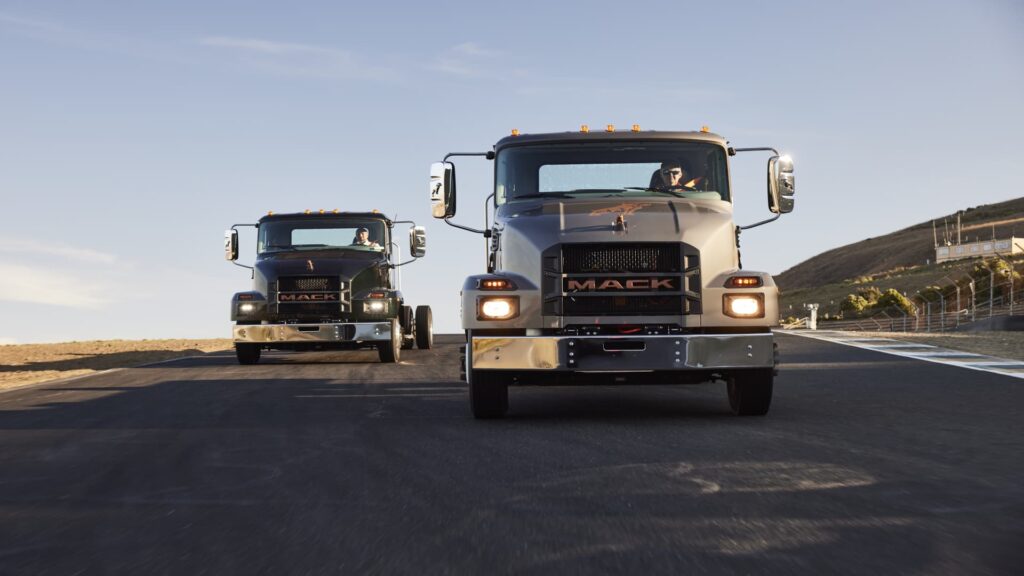Mack MD Electric Trucks.
Mack trucks
Mack Trucks, founded in Brooklyn, New York, in 1900, is known for its large, diesel-powered 18-wheel excavators with the distinctive Bulldog logo mounted on the hood. For 2021, this distinctive trim debuts in copper, rather than its usual gold, marking the venerable manufacturer's first foray into battery-powered electric vehicles. Appropriately, the LR Electric is a heavy-duty garbage truck, designed to pick up and dispose of all types of waste, without emitting any harmful greenhouse gases.
Mack has since delivered about 35 LRe to a growing number of cities — from New York City to Miami, Fla. — at an adoption rate that Jonathan Randall, president of Mack Trucks North America, describes as slow but steady.
“Cities are not receiving deliveries en masse, they are testing the technology to see how it works,” he said.
Mack is now headquartered in Greensboro, North Carolina, and is part of the Swedish Volvo Group and its Volvo Trucks unit, which produces its own brand of electric vehicles for the U.S. and overseas markets. Volvo Group's 2023 earnings report showed that Mack received 124 new orders for its battery electric vehicles last year, up from 44 in 2022, a 200% increase.
There's no doubt that electric vehicles are doing well, and not just Mack's, which also includes a medium-duty model, the MD Electric, introduced last March. Nearly every automaker — cars and trucks, large and small — produces some mix of all-electric models, plug-in hybrids, and gas-electric hybrids. Many OEMs have set targets to sell only zero-emission vehicles (ZEVs) by 2050, in line with the broad net zero goals of the 2015 Paris Climate Agreement to address global climate change. The transportation sector is the largest source of greenhouse gas emissions in the United States, accounting for 29% of total US emissions in 2021, according to the latest EPA statistics.
The multi-billion dollar question about purchasing electric cars
But beyond the feasibility of the technologies, the multi-billion-dollar question is whether, and when, customers will buy electric vehicles as the industry shifts away from internal combustion engines. Purchasing decisions differ between consumer and commercial markets, a difference that is reflected in last year's electric vehicle sales results in both sectors and expectations for future growth.
Although American consumers bought or leased a record 1.2 million electric vehicles in 2023, according to Kelley Blue Book — representing 46% year-over-year growth and raising the total EV market share to 7.6% from 5.9% in 2022 By the end of the year, the pace of growth slowed. Year-over-year electric vehicle sales rose 40% in the fourth quarter, but fell from 49% in the third quarter. Cox expects electric car sales this year to reach 1.5 million, about 36% higher than last year. In other words, the electric vehicle market in the United States is still growing, but not as quickly.
Automakers, from Ford to Tesla to General Motors, have been cutting prices for electric vehicles to stimulate demand, scaling back production targets for new electric vehicle models and shifting jobs back to traditional powertrain models, and appear more uncertain about the strict timelines they initially set for The transition to electric cars, with more talk about hybrid cars.
EDF noted a significant increase in EV truck deployments between 2020 and 2023. Eighty EV truck deployments were indexed in 2020, and those deployments jumped to 1,948 in 2022. Along with more than 10,000 deployments in 2023, the list tracked more than 12,894 average deployments. Heavy-duty electric trucks have entered service across the United States in the past four years. This increase includes Class 2 electric vehicles, such as electric trucks, which Amazon and other delivery services are using in increasing numbers.
Sales of all medium- and heavy-duty trucks — which make up only about 5% of vehicles on the road — totaled 507,277 in 2023, up 7.6% from 2022, according to the American Truck Dealers Association. The association does not indicate the number of electric vehicles sold.
“It's a different dynamic when you talk about business-to-business versus business-to-consumer relationships [markets] “And adopt this technology,” Randall said. “I know B2C has declined, from a demand standpoint. We really haven't seen interest wane. Of course, we haven't built the volumes of electric vehicles that automakers have, but interest is still very strong for us, and we'll just build them.”
ACT Research, a trucking industry analysis firm, shares Randall's optimism, if somewhat tempered. In September, the company released a study estimating that adoption rates for zero-emission and zero-carbon vehicles will reach 25% by 2030 and 50% by 2040. The study predicted a relatively low adoption rate from this year through 2026, though, “ Reflecting the fact that sales of battery-powered commercial vehicles are still in their early years, Anne Randle, vice president of electrification and autonomous driving, said, “This will start to change in 2027, in part due to upcoming changes in federal and state emissions regulations.” Which may lead to higher prices for diesel trucks.
Randall also echoed Randall's distinction about buyers. While the current decline in consumer demand for electric vehicles is mostly attributable to skyrocketing prices for ICE vehicles and concerns about charging – concerns about driving range and access to charging stations – commercial buyers are calculating TCO (total cost of ownership). “That's one of the biggest criteria,” Randle said. “It's a business asset. What's the return on investment?”
Mack has delivered about 35 LRe EV garbage trucks to a growing number of cities, from New York City to Miami, Fla., where the company describes the municipal effort as being in the “testing” phase.
Mack trucks
The initial cost of an EV truck is still relatively higher than an ICE model, so corporate fleet owners, private carriers and individual truck operators need to gauge how quickly they can reap the lower operating costs of EVs.
“You can significantly reduce aftermarket needs, because you have fewer moving parts in an electric vehicle,” said Matthias Holmberg, a Sweden-based analyst at DNB Markets. “Although there will still be routine maintenance costs for an electric vehicle, such as brakes and tires, they will not be as high as repairing or replacing the pistons, valves and other expensive components that make up the ICE, as well as the multi-speed transmission, which will help square the circuit.” the cost.
But even now, he said, when an owner looks at the total cost of ownership, which includes aftermarket parts and maintenance, driver wages, fuel consumption, insurance and so on, “that break-even point skews away from the large upfront investment.”
Holmberg said there are two critical factors in the total cost of ownership equation: battery technology and charging infrastructure, which are issues that every electric vehicle manufacturer faces. The battery remains the largest cost for electric vehicles, so reducing this cost, as well as battery power capacity, is a primary focus of truck OEMs' R&D investments.
“We need more energy-dense and cheaper batteries for this to be viable,” Holmberg said. “Given the development curve of where battery costs are headed, this will come in time. I would say we're still a few years away from reaching a break-even point where it makes perfect economic sense to make the switch.”
A study last year by the International Council on Clean Transportation and Energy Innovation found that by 2030, the total cost of ownership of long-range battery-electric trucks will likely be lower than their diesel counterparts.
Mack currently outsources its batteries, but moves by its parent company could cut out those middlemen. In 2022, the Volvo Group announced plans to build a large-scale battery factory in Sweden, which is expected to reach large-scale production by 2030. In early February, the Volvo Group completed its acquisition of Proterra, an American battery and electric bus company. The manufacturer filed for Chapter 11 bankruptcy last summer for $210 million. The deal includes a development center for battery modules and packs in California and an assembly plant in South Carolina.

As with the consumer electric vehicle market, where Tesla stands to make billions from its early investment in nationwide charging, creating sufficient and reliable nationwide battery charging infrastructure is a challenge facing the trucking industry. It is also a key element between the federal and state governments to drive the transition to commercial electric vehicles, especially long-distance heavy-duty semis.
There are a number of startups, including Freewire, TeraWatt Infrastructure, WattEV, Charge Point, they are building charging stations all over the country. In January, Volvo Group North America, Daimler Trucks, and Navistar – which together represent about 70% of the US medium- and heavy-duty truck market – formed the America's Commercial Transportation Support Alliance, an alliance to strengthen freight infrastructure.
The Biden administration's National Electric Vehicle Infrastructure Formula program, created by the bipartisan Infrastructure Act, provides $5 billion over five years to help build a charging network across the country. The Inflation Reduction Act also provides tax breaks to businesses for shipping equipment.
While the trucking industry and government agencies are working to make long-haul EV transportation more cost-effective, the situation for short-haul routes is more viable. “Commercial vehicles that operate a single shift, drive less than 100 miles per day and return to a local charging center, are great for maximizing the strengths of a battery-powered electric vehicle,” Randle said, which explains why Amazon, Wall Mart, FedEx, and UPS, also private short-haul shippers, are electrifying their fleets. Ports and marine terminals have seen an uptick in electric vehicles transporting shipping containers to domestic destinations.
The two Mack electric vehicles fit into the short-haul scenario and the company's e-mobility strategy. “The MDe can carry light payloads, work in urban environments and come home to a warehouse every night,” Randall said. Mack only had a few MDe's on the road as of mid-February, he said, “and we have a significant amount of backlog to deliver in the first half of this year.”
Mack manufactures both ICE and electric MDs at its facility in Roanoke, Virginia, and just announced it is investing $14.5 million to expand the facility. Randall hinted that Mack would look to build a heavy-duty electric vehicle for regional transportation, including transit. “We're in markets where we think it makes the most sense and there's continued, ongoing interest in adopting it,” he said.
Mack Trucks' network of approximately 420 dealers plays an integral role in this accreditation. About 80 of them have earned or are in the process of earning EV certification, which requires meeting Mack's requirements for safety, infrastructure, charging and tools.
To support dealers and address customer hesitation in adopting EVs, the company offers fleet management software, Turnkey Solutions, that covers all aspects of charging infrastructure development. Mack also offers an ElectriFi subscription, a leasing program that allows customers to pay as they travel for chassis and body mileage, freight, applicable incentives, property damage insurance and maintenance costs bundled into monthly payments.
“We will need the entire dealer network [to be EV-certified] “With e-mobility growing as a percentage of total sales,” Randall said, anticipating the day when every Mack truck has a copper-colored bulldog atop the hood.
